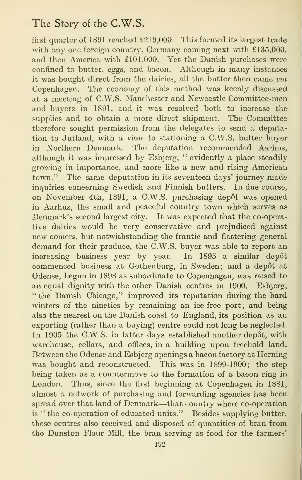Page 246 - The_story_of_the_C._W._S._The_jubilee_history_of_the_cooperative_wholesale_society,_limited._1863-1913_(IA_storyofcwsjubill00redf) (1)_Neat
P. 246
The Story of the C.W.S.
first quarter of 1891 reached £219,000. This formed its largest trade
with an}'" one foreign country, Germany coming next with £135,000,
and then America with £101,000. Yet the Danish purchases were
confined to butter, eggs, and bacon. Although in many instances
it was bought direct from the dairies, all the butter then came via
Copenhagen. The economy of this method was keenly discussed
at a meeting of C.W.S. Manchester and Newcastle Committee-men
and buyers in 1891, and it was resolved both to increase the
supplies and to obtain a more direct shipment. The Committee
therefore sought permission from the delegates to send a deputa-
tion to Jutland, with a view to stationing a C.W.S. butter buyer
in Northern Denmark. The deputation recommended Aarhus,
although it was impressed by Esbjerg, " evidently a place steadily
growing in importance, and more Hke a new and rising American
town." The same deputation in its seventeen days' journey made
inquiries concerning Swedish and Finnish butters. In due course,
on November 4th, 1891, a C.W.S. purchasing depot was opened
in Aarhus, the small and peaceful country town which serves as
Denmark's second largest city. It was expected that the co-opera-
tive dairies would be very conservative and prejudiced against
new comers, but notwithstanding the frantic and flattering general
demand for their produce, the C.W.S. buyer was able to report an
increasing business year by year. In 1895 a similar depot
commenced business at Gothenburg, in Sweden; and a depot at
Odense, begun in 1898 as subordinate to Copenhagen, was raised to
an equal dignity with the other Danish centres in 1900. Esbjerg,
"the Danish Chicago," improved its reputation during the hard
wmters of the nineties by remaining an ice-free port; and being
also the nearest on the Danish coast to England, its position as an
exporting (rather than a buymg) centre could not long be neglected.
In 1905 the C.W.S. in latter days estabhshed another depot, with
warehouse, cellars, and offices, in a building upon freehold land.
Between the Odense and Esbjerg openings a bacon factory at Hermng
was bought and reconstructed. This was in 1899-1900; the step
bemg taken as a countermove to the formation of a bacon ring in
London. Thus, since the first beginning at Copenliagen in 1881,
almost a network of purchasing and forwarding agencies has been
spread over that land of Denmark—that country where co-operation
"
is the co-operation of educated units." Besides supplying butter,
these centres also received and disposed of quantities of bran from
the Dunston Flour Mill, the bran serving as food for the farmers'
192

